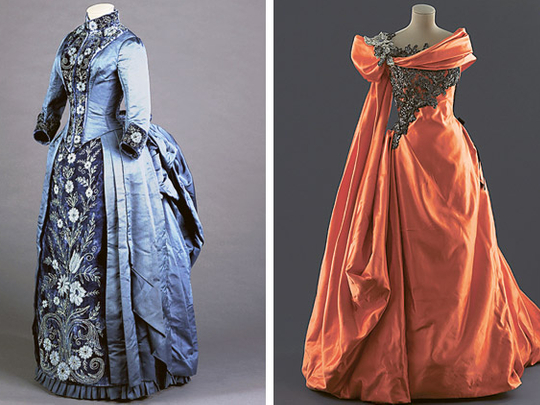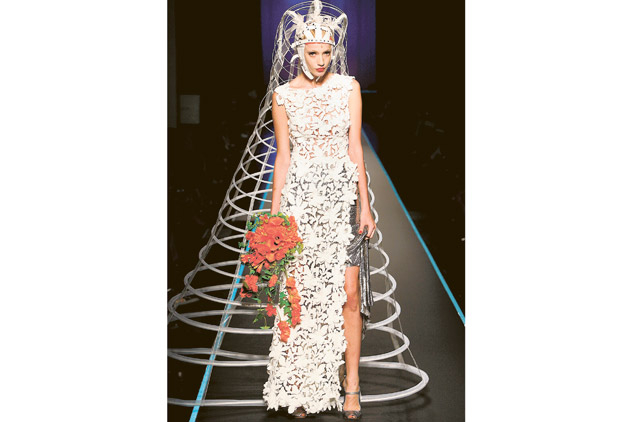
Muscat has recently been a privileged witness to exquisite examples of French vintage and haute couture wedding dresses and other related paraphernalia through the Galliera in Oman: 200 Years of French Wedding Dresses exhibition, showing at Bait Fransa, the Omani-French museum, since November 7.
On loan from Galliera, City of Paris Fashion Museum, until December 16, in conjunction with the French Embassy and the Ministry of Heritage and Culture, City of Paris and Paris Musee, the 35 dresses not only provide an insight into the evolution of French wedding fashion but also take into account and provide an illuminating commentary on simultaneously occurring social changes — such as the invention of cinema and the advent of the designer figure — that contributed to the metamorphosis of the wedding dress.
Featuring creations by France's iconic fashion designers, such as Jean-Paul Gaultier, Yves Saint Laurent, Chanel, Karl Lagerfeld and Christian Dior, the exhibition also artfully weaves in a multitude of historical objects and visual layers — such as dolls' clothing, quotations from French literary writers, cinema reels and wax-flower hair adornments — to create an interesting tapestry of experiences for the visitor.
The genesis of the exhibition occurred with the French Embassy's desire to commemorate through the medium of fashion — one of France's greatest cultural exports — the 40th anniversary of Sultan Qaboos Bin Saeed's reign in Oman.
It was thus decided that the wedding dress would be the theme, for the very nature of weddings and wedding dresses conjures up an atmosphere of gaiety and celebration.
"While the exhibition itself took a month and a half to set up, preparations began in May. The exhibition curator from Galliera, Anne Zazzo, came down to Oman, after which we saw the building and had discussions as to how we would present the exhibition," Filip Keunen, the exhibition art director, told Weekend Review.
Considering that the very title refers to a period of time — 200 years — the exhibition plays with the concept of time, in terms of both the presentation and the use of the architecture of the Bait Fransa — a 160-year-old two-storey building containing a confluence of Arab and Indian architectural styles.
Zazzo and Keunen were intent on the 11 rooms in Bait Fransa playing an important role in the exhibition, revealing it to be a house of discoveries. "The marriage between the pieces and the space/place was extremely significant," Keunen says. "We were playing with all notions of time — the chronological presentation of the dresses and the historical context of the building — and including items that contributed to changing the perception of time itself."
The ground floor is thus largely dedicated to dresses from the 19th to the early 20th century while the floor above contains haute couture wedding fashion 1970 onwards.
One of the most striking aspects of the exhibition is that the wedding dresses do not exist in isolation. While the dresses are narratives in themselves, as in the actual dresses and fashion that dictated their appearance, the team also incorporated them into being part of a greater social narrative occurring over time.
The decision to do so was in keeping with the exhibition's vision of playing with the idea of time. The specifically named rooms, such as the Cinema Room, indicates the impact moving images had on the world, allowing a moment to be relived, rather than be frozen in time, through the inclusion of a Lumiere brothers film reel.
Another room is dedicated to documenting the pictoral representation of wedding dresses over the past two centuries, etchings graduating to print and 20th-century glossy magazines. One also gets a glimpse of a doll that was used as a marketing and advertorial tool, with designers dressing it up in their creations and sending it to potential customers.
The room reveals the preoccupation with the wedding dress, predicated upon the assumption that it would be the most important dress a woman would wear in her life, given the sanctity of the wedding ritual and marriage and the attention dedicated to it, albeit in changing media avatars over time.
All the dresses have been donated to Galliera, the magnificence of the vintage dresses particularly underscoring the vigilant meticulousness with which they have been preserved. Apart from being valuable examples of sartorial heritage, Keunen says these dresses also expressly communicate bespoke wealth and status, the dress superseding its wearer and, indeed, its anonymous creator.
He says the French wedding was a highly codified affair in the 19th century, each ceremony necessitating a particular dress and additional accoutrements. To illustrate that purpose, the exhibition contains a sample of an 1885 wedding dress, along with a cobalt blue dress which was worn after the wedding ceremony. However, these elaborate rituals and ritual-specific dresses have long faded away, with the main wedding dress occupying centre stage now.
In addition to displaying a plethora of wedding dresses created by iconic designers, the show also explores the intimate relationship between wedding dresses and prevailing fashions.
"In earlier times, the style of the wedding dress coincided with that of mainstream fashion," Keunen says. The Cinema Room displays examples of daily-wear dresses alongside their contemporary wedding dresses.
However, the advent of the designer in the 1960s resulted in the wedding dress disassociating itself from contemporary fashion trends and occupying a new realm. "The designer respected the traditional elements of the wedding dress — the bouquet, the train and the veil — while injecting their own individuality into the dress," says Keunen, adding that the wedding dress serves as a veritable sum of the designers' creative abilities.
The fact that the wedding dress is the apogee of the designer's creative vision and happens to be the most significant and beautiful dress a woman is most likely to wear in her life renders the bride the ultimate heroine of the big day.
The designer figure thus initiated an era in which an individual's interpretation of the wedding dress was as much a testament to the wedding dress as to his or her own style palette. In Karl Lagerfeld's 1994 dress, he incorporates the iconic Chanel jacket into the structure of the dress, while Jean Paul Gaultier in his 2009 creation takes familiar elements out of context in an eclectic Post-Modern take, where the dress structure becomes the veil while the veil transforms into a dress.
"However, the interesting irony is that after 1960, none of these dresses are worn; they were all catwalk models," Keunen points out. "They function as designers' creative name-cards, works of art never to be sold."
Apart from the haute couture creations on the second floor, the ground floor houses more examples of fantastical wedding dresses, this particular display associated with fairytales. One is a dress crafted from paper while Jean-Charles de Castelbajac's 2000 creation is made from multiple miniature dolls' dresses, with a doll clinging to the back of the dress. The viewer can also see a ceramic green frog in the middle of the dress.
"The frog represents The Princess and the Frog fairytale, where the princess kisses the frog to see it transform into a prince," Keunen reveals, saying that the conjunction of the fairytale and the dresses goes back to the notion of the wedding being a fairytale affair many girls grow up dreaming about.
"The exhibition is interlaid with multiple layers and we presented many relevant links and associations with the wedding dresses," says Keunen, indicating the desire of the spectator to engage with the pieces on display and abstract their own stories from them.
For example, the room displaying dresses from the 19th century contains a necklace made of 27,000-year-old shells; the shells, discovered in 1868, serve as a link to a dress made that year. At other times, the relationship between the dress and the surrounding visual interventions are more abstruse.
For example, a time-lapse video of the Parisian sky studded with fluffy cumulous clouds refers to the billowing removable sleeves that a bride was expected to wear during the religious wedding ceremony on the day; the bride then removed the sleeves to wear the dress with shorter sleeves during the evening ball.
Quotes from renowned French literary figures such as Proust and De Balzac also adorn the walls, creating an installation-like interplay with words, dresses and objects.
Visitors can also see objects that helped contribute to the transformation of a woman into a bride: a 16th-century ivory comb, wax orange-blossom-shaped hair adornments from 1905 and delicate satin bridal shoes from 1830.
Yet the present is never far away, with fashion shoe aficionados finding the inclusion of a Christian Louboutin shoe fascinating, its trademark scarlet sole in dramatic contrast to that of the shoe's traditional white lace and corsage elements.
The wedding dress is a coveted item, representing beauty, love and the promise of everlasting happiness within its folds. The Galliera exhibition reaffirms these associations through the beautiful examples on display while also putting them in a context that takes them beyond the confines of a wedding and into a larger sociocultural picture.
Priyanka Sacheti is an independent writer based in Muscat.
Galliera in Oman: 200 Years of French Wedding Dresses is on at Bait Fransa in Muscat until December 16.













